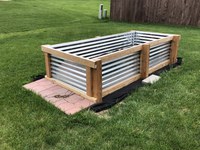Dakota Gardener: Can a Raised Garden Bed Be Functional and Beautiful?
(Click an image below to view a high-resolution image that can be downloaded)
By Esther McGinnis, NDSU Extension Horticulturist
Many apologies to my patient neighbors!
My first raised garden bed was admittedly an eyesore. We did a standard raised garden bed using cedar 2x10s as the frame.
Within 15 minutes of filling the bed with a soil mixture, a stray cat brazenly jumped into the low bed and used it as a litter box. To prevent feral cats and hungry wildlife from interfering with my new garden, we quickly erected a removable fence out of PVC pipe and chicken wire, hence the eyesore.
Cognizant of neighborhood aesthetics, my patient husband constructed a taller raised garden bed that doesn’t require ugly fencing. This new bed measures 2 feet tall by 8 feet long and 4 feet wide, and has an attractive frame of galvanized metal and pressure-treated wood.
Construction was fairly simple. The long sides consist of sheets of 8- by 2-foot galvanized metal that are supported by 2x4s. Three 4x4 posts provide sturdy vertical support. The 4- by 2-foot end walls are constructed in a similar manner and then secured to the 4x4 posts. For detailed construction methods, visit this DIY website: http://blueberryhillcrafting.com/2013/04/24/how-to-galvanized-garden-beds.
Besides having a beautiful appearance, the galvanized beds are very functional and durable. The taller height will deter rabbits. Fingers crossed - I haven’t noticed any cats so far. Furthermore, the elevated height will save my middle-aged back from bending over.
As our population ages, we need to consider adaptive methods to continue gardening late into life as the aches and pains grow. Scientific studies show that elderly gardeners score higher than their counterparts on most major health indices. This is a great incentive to continue gardening.
Some important points to consider in building a raised garden bed include:
- Put down chicken wire or wire mesh on the bottom of the raised bed to deter pesky rodents.
- Use landscape fabric or weed barrier on the bottom to keep out grass rhizomes.
- Don’t build a raised bed that is more than 4 feet across; a comfortable reaching distance from either side of the bed is 2 feet across.
Finally, what sort of soil mix should you add? Popular media and websites recommend large proportions of organic matter such as peat moss and compost. However, personal experience has taught me that too much organic matter in raised garden beds is problematic.
Organic matter will decompose and settle dramatically from year to year. In addition, organic matter dries out a little quickly. Therefore, I am going to use a mix of approximately two-thirds topsoil and one-third peat moss by volume.
For more information, contact your local NDSU Extension agent. Find the Extension office for your county at https://www.ag.ndsu.edu/extension/directory/counties.
NDSU Agriculture Communication - May 26, 2020
| Source: | Esther McGinnis, 701-231-7971, esther.mcginnis@ndsu.edu |
|---|---|
| Editor: | Ellen Crawford, 701-231-5391, ellen.crawford@ndsu.edu |




